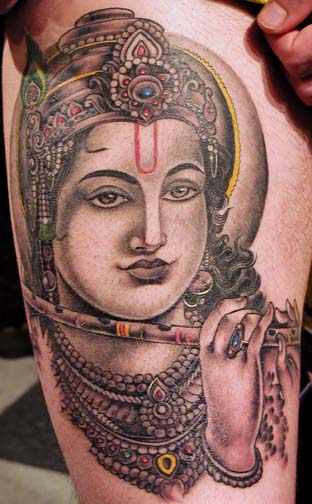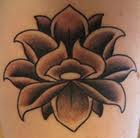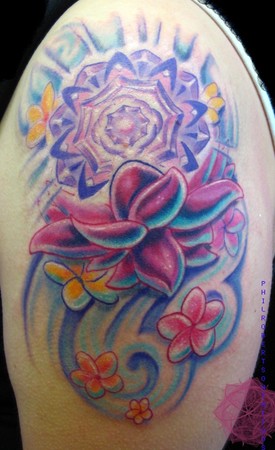Overview About Tibetan Tattoo History
 In recent years, Tibetan tattoos have become increasingly popular, mostly due to celebrity adoption of the ancient art. The Tibetan language has existed for many centuries and is considered sacred. Many tattoo artists specialize in the Tibetan language and calligraphy and are considered experts in the art. Tibetan tattoos consist mostly of phrases or words translated into the Tibetan language, which took centuries to develop.
In recent years, Tibetan tattoos have become increasingly popular, mostly due to celebrity adoption of the ancient art. The Tibetan language has existed for many centuries and is considered sacred. Many tattoo artists specialize in the Tibetan language and calligraphy and are considered experts in the art. Tibetan tattoos consist mostly of phrases or words translated into the Tibetan language, which took centuries to develop.
The written Tibetan language first began in the seventh century, when King Songsten Gampo commissioned the translation of the Sanskrit texts of Buddhist into a new Tibetan language. This highly involved form of calligraphy took nine generations to fully develop, with each generation adding to the script style and design. In the 19th century, the Tibetan script that is still in use today was finally perfected. Calligraphy was considered a vital part of Tibetan education, with students spending anywhere from 10 to 15 years learning how to write differing styles.
The Lotus Flower
 The lotus flower is a powerful symbol for the Buddhists and among the most common of Buddhist art tattoos. The lotus flower rises from the marsh and swamp to finally open its bloom at the water’s surface. This powerful symbol represents the spiritual awakening that is found once we reach past all of the distraction and temptation of the physical world.
The lotus flower is a powerful symbol for the Buddhists and among the most common of Buddhist art tattoos. The lotus flower rises from the marsh and swamp to finally open its bloom at the water’s surface. This powerful symbol represents the spiritual awakening that is found once we reach past all of the distraction and temptation of the physical world.
The lotus flower is often used in a Tibetan tattoo design to show the spiritual development of the wearer or to remind the wearer of what they hope to achieve. It is often used with the mantra Om Mani Padme Hum to show spiritual growth. Some will focus on one part of the Om Mani Padme Hum and have it added to the lotus flower tattoo after great meditation, contemplation, and understanding of the virtue they are trying to invoke.
The lotus flower has different meanings depending on how it is drawn and the colors used. The blossom is considered a symbol of purity, the color symbolizes a purity of a specific nature:
- Pink blossoms are used to represent the purity of Buddha himself. Tattoos of this nature will remind people what they hope to achieve.
- White blossoms show the purity of the mind and body.
- Red blossoms may show the purity of emotion or the heart.
- Blue can represent the purity wisdom and the mastery over physical desire and longing.
Just as important as the color is the stage that the bloom depicted:
- An unopened bloom would symbolize the potential the individual has. A reminder of what virtue they seek to enlightenment.
- An opened blossom would represent the achievement of enlightenment.
Tibetan “Sanskrit” Tattoos
Many people are looking for Tibetan “Sanskrit” tattoos, but there is no such thing as Tibetan Sanskrit, both terms refer to a different language.
Sanskrit is an old language, the language of the classic literature of India. Sanskrit is a cultural language and was used by the elite, a bit like Latin in the West.
Tibetan on the other hand is the every-day language of the Tibetan people. Tibetan grammar is based on Sanskrit grammar and the Tibetan script is based on Devanagari, the script also used by Sanskrit and Hindi. But there the similarities with Sanskrit stop.
Om Mani Padme Hum
The word mantra means mind protection and a mantra is a series of symbols that evoke a spiritual written, spoken, or sung response. Om Mani Padme Hum is the most common of all Buddhist mantras and is used to invoke the blessings of Chenrezig (Avalokiteshvara, where of the Dalai Lama is the reincarnation), the Buddhist deity that represents ultimate compassion. This prayer is repeated as part of meditation.
There is no accurate direct translation of this mantra, it is believed to contain all of the teachings of Buddha. Each syllable has a special meaning, symbol and color within Tibetan writing:
Om
Generosity (purifies pride/bliss)
Ma
Ethics (purifies jealousy/lust for entertainment)
Ni
Patience (purifies passion/desire)
Pad
Diligence (purifies ignorance/prejudice)
Me
Renunciation (purifies poverty/possessiveness)
Hum
Wisdom (purifies aggression/hatred)
Om Mani Padme Hum tattoos are more than just the words or symbols, they are often part of a larger tattoo incorporating the lotus flower or broken into their individual elements. When each syllable is present, the tattoo is used to focus the wearer to a specific aspect or trait the symbol would represent.
Om Tattoos
The Aum symbol, also called the Om, is used to emphasize the virtue of generosity or as a ward against the vices of pride or bliss. Combined with the symbol of the lotus flower, this is a powerful image showing the growth of the virtue over the vices.
Deity & Demon Tattoos
Tibetan tattoos have a very different style of personalities involving deities, demons and other figures of high regard.
Unlike western religions, demons are not always associated with evil and corruption. In Buddhist tattoo art, demons are often represented as frightening and chaotic forms, however, that is not to imply that they are evil. Instead, they represent the elements in nature and the chaotic nature of man.
Some of these demons take the form of the Naga, looking like a serpent or dragon. In some form of Buddhism, demons are simply polar opposites of the virtues and the corresponding deity. Tattoos that display this type of demon are used to remind the wearer of the virtues that they should aspire.
The girl in the next picture has a beautiful back tattoo of Chenrezig (Avalokiteshvara in Sanskrit), the bodhisattva of compassion.
The Buddha
The Buddha, born in India around 563 BCE as Siddhartha Gautama, is the founder of Buddhism. The word Buddha means “enlightened one”. A Buddha is not a god in the big “G” sense of the word but an ordinary person who has developed all the positive qualities of human nature an rid themselves of all the negative qualities.
Buddha did not like having his image or other icons used for worship. So in the pure Buddhist sense it might be a good idea to look for other representations of Buddha in your tattoo art:
- The lion is used as a symbol of strength, the strength that is needed to adhere to the teachings of Buddha.
- A Dharma wheel or prayer wheel, representing the teachings of Buddha’s eight-fold mantra.
- A Bodhi tree symbolizes Buddha and is held to be the place where Buddha achieved his enlightenment.
- The pink lotus is a symbol of Buddha himself, and the highest level of purity.
- Tattoos of footprints represent the following of Buddha’s path of enlightenment.
That being said, the majority of people don’t care what the Buddha said about worshipping because he is a central figure in a lot of Buddhist art and tattoo art.
Eternal Knot Tattoos
Deep in the Buddhist faith is a belief in patterns that can be used to lead people to universal and spiritual awakenings. These can be complex interweaving knots and scripts mingled together into a oddly ordered chaos, or a simple and relaxed geometric design that lends itself to simple understanding. The most common of these types of tattoos are the eternal knot, mandala tattoos, and Tibetan skull tattoos.
This artistic design of the eternal knot (aka endless knot or mystic knot) has great symbolic meaning because there is no beginning or end to the pattern. It is said to represent the circle of samsara showing birth, life, death and rebirth. It shows the infinite wisdom of Buddha, since it has no beginning or end. This can be used as a stand alone tattoo or as part of a more complicated work.
The Tibetan knot, similar to the Celtic knot, is a series of interconnected diamond shapes that could be enhanced with a vast array of textures, color, 3-D design or calligraphy. Some of these designs appear in wood, bronze, or wax. Some knots have intricate design within the knot structure adding an additional texture to the simple form.
An intricate and colorful work of Tibetan art is the mandala (Sanskrit word for circle). Created in sand, glass, precious metals, wax, ink and stone, the mandala is another form of expressing prayer or meditation.
Mandala tattoos symbolize unity and harmony, through the use of concentric structure. Used to show the universal order, balanced elements absorb the observer and are commonly used in meditation. This meditation tool represents the universe, life, death and all of creation. One might meditate on all the aspects of life as they gaze into the rich, cultural lore within the Mandala.
As an art form, mandalas are visually captivating and can draw in the viewer. Some describe the effects of a mandala as hypnotic and can lead the viewer to a higher level of consciousness. There are a variety of styles that are used in tattoo art and choosing the one that best suites the wearer is greatly a matter of aesthetic choice.
Tibetan Skull Tattoos
Tibetan skull tattoos are often combined with other Buddhist elements to show the temporary and changing nature of life. The skull in Tibetan tattoos represents that changing nature, it also shows the practitioner has stopped attachment to the physical body. It is the attachment to the body that ties people to the pain and suffering of the world.
Tibetan tattoos are a wonderfully artistic way to express the spiritual side of the wearer. Even those that are not Buddhist cannot miss the powerful nature of the symbolism. The variety of symbols, the deep meaning behind them, and the never ending stories they can combine to tell make Tibetan tattoos a beautiful and powerful form of body art.

